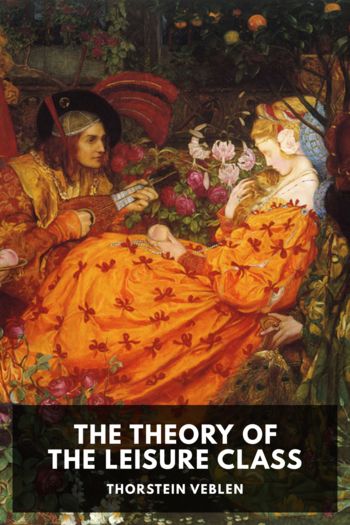The Theory of the Leisure Class by Thorstein Veblen (phonics readers TXT) 📕

- Author: Thorstein Veblen
Book online «The Theory of the Leisure Class by Thorstein Veblen (phonics readers TXT) 📕». Author Thorstein Veblen
Everyday life affords many curious illustrations of the way in which the code of pecuniary beauty in articles of use varies from class to class, as well as of the way in which the conventional sense of beauty departs in its deliverances from the sense untutored by the requirements of pecuniary repute. Such a fact is the lawn, or the close-cropped yard or park, which appeals so unaffectedly to the taste of the Western peoples. It appears especially to appeal to the tastes of the well-to-do classes in those communities in which the dolicho-blond element predominates in an appreciable degree. The lawn unquestionably has an element of sensuous beauty, simply as an object of apperception, and as such no doubt it appeals pretty directly to the eye of nearly all races and all classes; but it is, perhaps, more unquestionably beautiful to the eye of the dolicho-blond than to most other varieties of men. This higher appreciation of a stretch of greensward in this ethnic element than in the other elements of the population, goes along with certain other features of the dolicho-blond temperament that indicate that this racial element had once been for a long time a pastoral people inhabiting a region with a humid climate. The close-cropped lawn is beautiful in the eyes of a people whose inherited bent it is to readily find pleasure in contemplating a well-preserved pasture or grazing land.
For the aesthetic purpose the lawn is a cow pasture; and in some cases today—where the expensiveness of the attendant circumstances bars out any imputation of thrift—the idyl of the dolicho-blond is rehabilitated in the introduction of a cow into a lawn or private ground. In such cases the cow made use of is commonly of an expensive breed. The vulgar suggestion of thrift, which is nearly inseparable from the cow, is a standing objection to the decorative use of this animal. So that in all cases, except where luxurious surroundings negate this suggestion, the use of the cow as an object of taste must be avoided. Where the predilection for some grazing animal to fill out the suggestion of the pasture is too strong to be suppressed, the cow’s place is often given to some more or less inadequate substitute, such as deer, antelopes, or some such exotic beast. These substitutes, although less beautiful to the pastoral eye of Western man than the cow, are in such cases preferred because of their superior expensiveness or futility, and their consequent repute. They are not vulgarly lucrative either in fact or in suggestion.
Public parks of course fall in the same category with the lawn; they too, at their best, are imitations of the pasture. Such a park is of course best kept by grazing, and the cattle on the grass are themselves no mean addition to the beauty of the thing, as need scarcely be insisted on with anyone who has once seen a well-kept pasture. But it is worth noting, as an expression of the pecuniary element in popular taste, that such a method of keeping public grounds is seldom resorted to. The best that is done by skilled workmen under the supervision of a trained keeper is a more or less close imitation of a pasture, but the result invariably falls somewhat short of the artistic effect of grazing. But to the average popular apprehension a herd of cattle so pointedly suggests thrift and usefulness that their presence in the public pleasure ground would be intolerably cheap. This method of keeping grounds is comparatively inexpensive, therefore it is indecorous.
Of the same general bearing is another feature of public grounds. There is a studious exhibition of expensiveness coupled with a make-believe of simplicity and crude serviceability. Private grounds also show the same physiognomy wherever they are in the management or ownership of persons whose tastes have been formed under middle-class habits of life or under the upper-class traditions of no later a date than the childhood of the generation that is now passing. Grounds which conform to the instructed tastes of the latter-day upper class do not show these features in so marked a degree. The reason for this difference in tastes between the past and the incoming generation of the well-bred lies in the changing economic situation. A similar difference is perceptible in other respects, as well as in the accepted ideals of pleasure grounds. In this country as in most others, until the last half century but a very small proportion of the population were possessed of such wealth as would exempt them from thrift. Owing to imperfect means of communication, this small fraction were scattered and out of effective touch with one another. There was therefore no basis for a growth of taste in disregard of expensiveness. The revolt of the well-bred taste against vulgar thrift was unchecked. Wherever the unsophisticated sense of beauty might show itself sporadically in an approval of inexpensive or thrifty surroundings, it would lack the “social confirmation” which nothing but a considerable body of like-minded people can give. There was, therefore, no effective upper-class opinion that would overlook evidences of possible inexpensiveness in the management of grounds; and there





Comments (0)